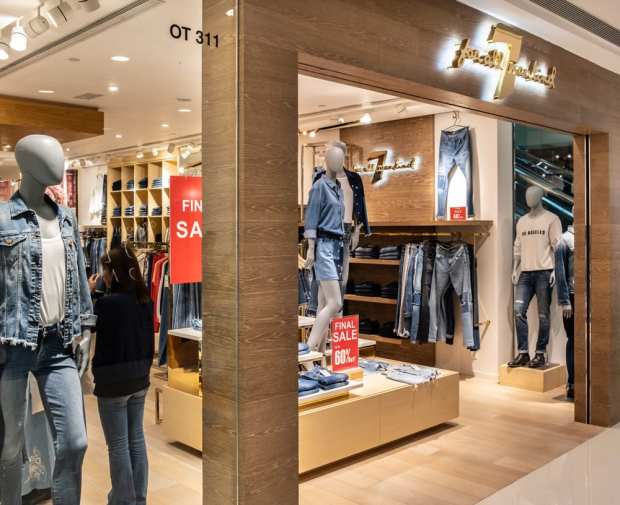How Delta Galil’s Fashion Brands Use BNPL To Boost Loyalty

The fashion world moves fast to serve consumers and merchants searching for the next new thing — and for the most convenient and cost-effective ways to pay. Keeping up with fashion can be expensive for the younger demographics the industry typically targets, making debt-wary shoppers reconsider possible purchases.
Younger consumers expect instant gratification and affordable ways to obtain the goods they desire, prompting more retailers to adopt buy now, pay later (BNPL) payment services. This is especially true among eCommerce brands facing high levels of cart abandonment, according to Geoff Staff, vice president of retail and eCommerce for Delta Galil Premium Brands.
Both of the company’s 7 For All Mankind and Splendid brands recently partnered with BNPL solutions provider Afterpay, enabling consumers to make installment payments on their purchases and increase access to sought-after items while maintaining the convenience of online purchasing processes. Delta Galil spoke with numerous BNPL platforms before selecting Afterpay and decided to offer alternative payment methods due to their noted impact on customer conversion, Staff said in a recent interview with PYMNTS.
“The commonality is the ability to bring new customers to a brand, and that is critical,” he explained, noting that this is observable even in the short-term: 7 For All Mankind and Splendid only began offering Afterpay in Q4 of 2019.
“[BNPL is] a solid and strong customer acquisition tool,” he continued. “In fact, the data has shown that the [BNPL] brands that have some maturity to them [have] actually brought in younger customers.”
Attracting young consumers is becoming more important as commerce continues to shift online and to mobile. Staff noted that approximately 55 percent to 75 percent of brands’ initial web traffic now occurs through mobile devices. Ensuring that payments remain easy and cost-effective for mobile customers is critical to competing.
The Importance of Financial Flexibility
Fashion is projected to generate $712.9 billion in eCommerce revenue annually by 2022, meaning brands must bring in Gen Z and millennial shoppers. These consumers have more and more spending power, and companies looking to succeed will have to entice them — but doing so is only half the battle. Cart abandonment continues to be a concern, as the abandonment rate for the fashion industry hovered around 83 percent in December of 2019.
“There [are] definitely … customers who will continue to shop online to preview prospects or research brands before … going to brick-and-mortar stores,” Staff said. “So, as a result of that, [there are] more and more brands in the fashion industry really being challenged by [this]. How do you get customers to try your [brand]? How do you get them to give you a test run?”
Flexible payment options could solve some of these issues for online fashion and beauty retailers looking to attract and also convert customers. This can be especially beneficial for brands offering more expensive products, as consumers may be reluctant to try unfamiliar stores in the mid-tier and luxury ranges. BNPL offerings can ease the financial concerns that may hold consumers back from what they consider to be experimental first purchases, Staff explained.
“[Getting] a consumer [to] try a $200 silk blouse from 7 For All Mankind could be a reach,” he said, adding that it is easier to convince consumers to try outfits when they are paying less expensive installments. “[It] does not feel like as much of a reach.”
The Next BNPL Wave
Staff believes that BNPL offerings will continue to spread throughout the fashion world, serving the growing number of consumers searching for easier, wallet-friendly payment methods. He did note that some companies, such as luxury fashion players, may not adopt installment payments for some time, as they have different target demographics. Their marketing focuses on exclusivity to drive spend from higher-income consumers who may not need the financial assistance that installment payments can provide.
This is different from what may be the expected BNPL growth trend. Installment payments have a reputation for helping consumers afford larger-ticket items in other fields, and are associated with car loans or mortgage payments.
“I think the biggest change [for fashion] is you have seen [BNPL] move from mass- and mid-market to [higher-tier] brands,” Staff said. “If you really think about it, why would mid-market, maybe even down-market, [companies] have a payment plan versus more aspirational products at a higher price point?”
Today’s consumers are placing more value on aspirational products and services, meaning BNPL and luxury fashion may not be as diametrically opposed as some retailers may think. Luxury brands may find BNPL use cases in the near future that they had not previously entertained.
It is still too early to tell how BNPL offerings could impact luxury fashion, but consumers and retailers in the wider fashion world are continuing to experiment with the benefits of installment payments. Easing financial strain and ensuring shopping convenience will likely remain important for these retailers as customers’ behaviors continue to evolve.
